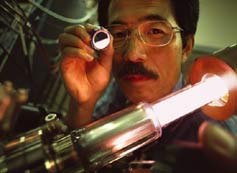
Handy Links
SLAC News Center
SLAC Today
- Subscribe
- Archives: Feb 2006-May 20, 2011
- Archives: May 23, 2011 and later
- Submit Feedback or Story Ideas
- About SLAC Today
SLAC News
Lab News
- Interactions
- Lightsources.org
- ILC NewsLine
- Int'l Science Grid This Week
- Fermilab Today
- Berkeley Lab News
- @brookhaven TODAY
- DOE Pulse
- CERN Courier
- DESY inForm
- US / LHC
SLAC Links
- Emergency
- Safety
- Policy Repository
- Site Entry Form

- Site Maps
- M & O Review
- Computing Status & Calendar
- SLAC Colloquium
- SLACspeak
- SLACspace
- SLAC Logo
- Café Menu
- Flea Market
- Web E-mail
- Marguerite Shuttle
- Discount Commuter Passes
-
Award Reporting Form
- SPIRES
- SciDoc
- Activity Groups
- Library
Stanford
Around the Bay
ILC Innovation: Improving the Photocathode
 When built, the International Linear Collider (ILC) will generate one of the
world's highest energy electron beams. And it will all start with an electron
source called a cathode. This source releases the electrons when hit by laser
and is the size of a nickel.
When built, the International Linear Collider (ILC) will generate one of the
world's highest energy electron beams. And it will all start with an electron
source called a cathode. This source releases the electrons when hit by laser
and is the size of a nickel.
SLAC physicist Takashi Maruyama has spent twenty years studying photocathodes and is now working on one for the ILC. Using an innovative design for these crucial wafers, he has greatly increased their efficiency.
The ILC will require a high energy beam that is polarized, meaning that the electrons must all spin in the same direction.
Photocathodes are made of gallium arsenide, a semi-conductor grown as a crystal. By itself, gallium arsenide polarizes a beam at about 50 percent. In 1991, Maruyama and his collaborators increased the polarization to 80%. For certain measurements, the improved polarization even allowed SLAC detectors to outperform CERN's LEP, which had 30 times more events. For the ILC, Maruyama is challenged to reach even higher polarization.
To do this, he alternated layers of gallium arsenide with gallium arsenide phosphide in the top 100 nanometers of his cathode disk, like a stack of tightly-packed pages, one hundred thousandth the thickness of a single piece of printer paper.
Today, thanks to the new layering technique, almost 90 percent of the electrons spin in the same direction.
In addition to this polarization increase, the layering technique has also improved the gallium arsenide quality and increased efficiency in electron production.
Although his work has reached the ILC expectation, Maruyama continues to refine his design. “We are trying to reach 100 percent, with all electrons in one polarization,” he said.
—Erik Vance
SLAC Today, March 28, 2006